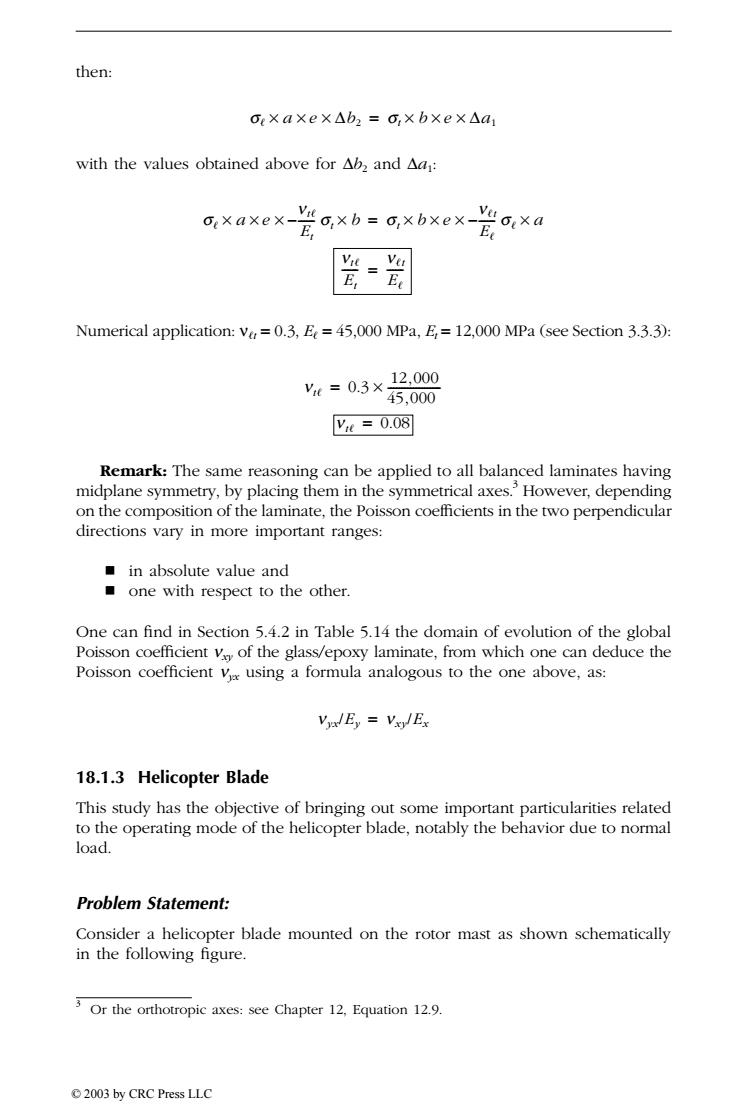正在加载图片...

then: oe×a×e×△b2=o,×b×e×△a1 with the values obtained above for△b2and△a: axaxex-YG,xb=a,xbxex-wu oxa E, Numerical application:v=0.3,E=45,000 MPa,E,=12,000 MPa (see Section 3.3.3): Vt=0.3× 12,000 45,000 Vt=0.08 Remark:The same reasoning can be applied to all balanced laminates having midplane symmetry,by placing them in the symmetrical axes.'However,depending on the composition of the laminate,the Poisson coefficients in the two perpendicular directions vary in more important ranges: in absolute value and one with respect to the other. One can find in Section 5.4.2 in Table 5.14 the domain of evolution of the global Poisson coefficient vy of the glass/epoxy laminate,from which one can deduce the Poisson coefficient via using a formula analogous to the one above,as: VylEy Vx/Ex 18.1.3 Helicopter Blade This study has the objective of bringing out some important particularities related to the operating mode of the helicopter blade,notably the behavior due to normal load. Problem Statement: Consider a helicopter blade mounted on the rotor mast as shown schematically in the following figure. Or the orthotropic axes:see Chapter 12,Equation 12.9. 2003 by CRC Press LLCthen: with the values obtained above for Db2 and Da1: Numerical application: nt = 0.3, E = 45,000 MPa, Et = 12,000 MPa (see Section 3.3.3): Remark: The same reasoning can be applied to all balanced laminates having midplane symmetry, by placing them in the symmetrical axes. 3 However, depending on the composition of the laminate, the Poisson coefficients in the two perpendicular directions vary in more important ranges: in absolute value and one with respect to the other. One can find in Section 5.4.2 in Table 5.14 the domain of evolution of the global Poisson coefficient nxy of the glass/epoxy laminate, from which one can deduce the Poisson coefficient nyx using a formula analogous to the one above, as: 18.1.3 Helicopter Blade This study has the objective of bringing out some important particularities related to the operating mode of the helicopter blade, notably the behavior due to normal load. Problem Statement: Consider a helicopter blade mounted on the rotor mast as shown schematically in the following figure. 3 Or the orthotropic axes: see Chapter 12, Equation 12.9. s ¥ a e ¥ ¥ Db2 = st ¥ b e ¥ ¥ Da1 s a e nt Et ¥ ¥ ¥ –------ st ¥ b st b e nt E = ¥ ¥ ¥ –------ s ¥ a nt Et ------ nt E = ------ nt 0.3 12,000 45,000 = ¥ ------------------- nt = 0.08 nyx/Ey nxy = /Ex TX846_Frame_C18a Page 347 Monday, November 18, 2002 12:40 PM © 2003 by CRC Press LLC